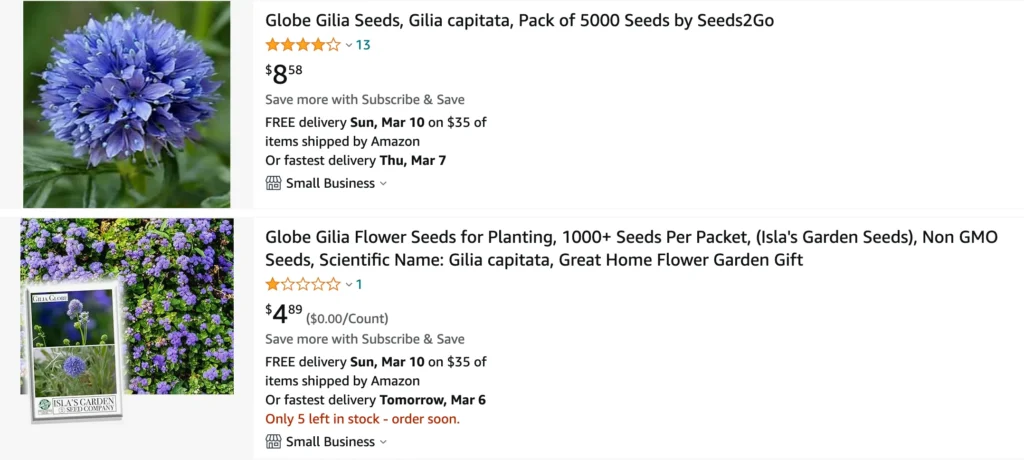
A Californian Dream: My Adventures with Gilia Capitata
For years, my garden craved a touch of California magic. The vibrant blue skies and the carefree spirit of the West Coast seemed elusive, but then I discovered Gilia capitata, the Globe Gilia. This little wildflower, native to western North America, brought a burst of sunshine and a whole lot of charm to my backyard.
Growing Gilia capitata has been an absolute joy. It’s a low-maintenance plant that thrives on neglect, perfect for a busybody like me. But before you dive headfirst into planting these beauties, let’s explore what makes them special and how to cultivate your own Californian dream in your garden.
39 Species in Genus Gilia
What is Gilia capitata?
Gilia capitata, also known as Globe Gilia or Blue Gilia, is a member of the phlox family. It’s an annual wildflower that boasts stunning, globe-shaped clusters of vivid blue flowers. The blooms are lightly fragrant and a magnet for pollinators, especially butterflies and hummingbirds. Gilia capitata typically grows 6-24 inches tall, adding a touch of whimsy and color to borders, beds, or even containers.
How to Grow Gilia capitata?
The beauty of Gilia capitata lies in its easygoing nature. Here’s how to bring this Californian charm to your garden:
- Sowing: Gilia capitata is a champion of flexibility. You can sow seeds directly outdoors in fall, winter, or even spring. Opt for a location bathed in sunshine and blessed with well-drained soil. The seeds are tiny, so sprinkle them lightly on the soil surface and gently press them in. No need to cover them with soil.
- Germination and Growth: Mother Nature takes care of most of the work. With consistent moisture, especially during germination, your Gilia capitata seedlings should emerge within a couple of weeks. Once established, these little troopers become quite drought tolerant.
- Spacing: As the seedlings grow, thin them to allow 9-15 inches of space between each plant. This ensures proper air circulation and encourages bushier, sturdier growth.
How to Care for Gilia capitata?
Gilia capitata thrives on neglect. Here’s the minimal effort required to keep your Californian dream alive:
- Watering: Water regularly during germination and the initial establishment period. Once established, Gilia capitata’s drought tolerance kicks in. Water deeply only during extended dry spells.
- Deadheading: To encourage continuous blooms throughout the season, deadhead spent flowers regularly. Simply snip off the wilted flower heads using sharp pruners. This not only keeps your garden looking tidy but also signals the plant to produce more blooms.
- Fertilizer: Gilia capitata isn’t a fertilizer fiend. In fact, excessive feeding can lead to leggy growth with fewer flowers. Average to poor soil is perfectly acceptable for these wildflowers.
What to Plant with Gilia capitata?
Gilia capitata’s vibrant blue flowers pair beautifully with a variety of plants. Here are a few ideas for a Californian tapestry in your garden:
- Yellow Companions: Create a sunny symphony by planting Gilia capitata alongside yellow blooms like California poppies, coreopsis, or yellow yarrows.
- Complementary Purples: Lavender, Russian sage, and Salvia offer a calming contrast to the vibrant blue of Gilia capitata, creating a soothing and harmonious effect.
- Native Delights: Embrace the Californian spirit by surrounding your Gilia capitata with other native wildflowers like Yarrow, Blanketflower, or California Aster.
More Than Just Beauty: The Benefits of Gilia capitata
Gilia capitata’s charm extends beyond its aesthetic appeal. Here are some additional reasons to consider adding these wildflowers to your garden:
- Pollinator Paradise: Gilia capitata attracts a variety of pollinators, including butterflies, bees, and hummingbirds. This not only benefits your garden ecosystem but also contributes to a healthy environment.
- Low-Maintenance Marvel: As mentioned before, Gilia capitata requires minimal care. It’s perfect for busy gardeners or those who prefer a more hands-off approach.
- Self-Seeding Surprise: Gilia capitata readily self-sows, ensuring a delightful surprise of blue blooms year after year.
With its easygoing nature, captivating beauty, and ecological benefits, Gilia capitata has become a cherished member of my garden. It’s a constant reminder of the Californian sunshine and a testament to the joy of low-maintenance gardening. So, why not bring a touch of the West Coast magic to your own backyard and embark on your Gilia capitata adventure?
If i die, water my plants!



